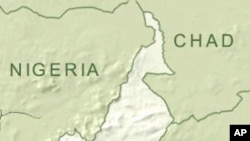A sustainable aquarium fish-breeding program backed by the World Bank and World Fish Center is improving living conditions for villagers in Cameroon.
Hundreds of thousands of Americans collect exotic aquarium fish and the the global ornamental fish industry is believed to be worth around $570 million. Many species of popular aquarium fish come from West Africa, specifically the Lower Guinean rain-forest in Cameroon.
Though some species of ornamental fish have been successfully bred in states such as Florida, a sustainable fish-breeding project backed by the World Fish Center is improving livelihoods in rural parts of Cameroon.
Randall Brummett is a senior scientist in Cameroon with the World Fish Center.
"We have set up a network of fishing communities around Southern and Central Cameroon. Many of the people have small ponds and have been taking part in all different kinds of training programs to improve their handling of the fish," Brummett said.
The World Fish Center's program is the first initiative to pay fishers fair wages. Brummett said in the past aquarium fish exporters focused too heavily on imagined high profit margins and did not pay enough attention to the care of the fish.
Species such as the shimmering epiplatys, striped barbus jae and the red-toothed pungu are collected in streams and river basins with hand-held nets. Fishers receive up to 20 cents for each fish. The catch is then shipped to the United States or Europe for sale in pet stores and specialist aquatic shops.
Brummett said most of the species collected thrive in Cameroon's warm waters.
"Virtually all of them are endemic to the Lower Guinean rain-forest," he said.
The program, which aims to revitalize the local industry, was launched after Brummett received a phone call from a veterinarian at the main airport in Paris.
"The veterinarian at Charles de Gaulle Airport in Paris called me up one day and said, 'I am constantly getting shipments of ornamental fish from Cameroon and they arrive 90 percent dead," Brummett said.
Aquarium fish companies are paid for the number of live fish that arrive in each shipment. Brummett noticed that many of the companies would hold fish in plastic bags for up to two weeks, compromising their health and mortality rate.
Some funding has been provided by the World Bank for the World Fish Center's project, which aims for a low mortality rate while also sensitizing local authorities on the value of rain-forest river ecosystems and lobbying for their protection.
Brummett said the fish collection areas are spread out all over Cameroon, from the slopes of Mount Cameroon to the borders with Equatorial Guinea and Gabon.
"It is important to go and visit all these sites and collect all the fish, but you have to have a storage facility that is big enough to hold fish for a month or two," he said.
The current storage facility, operated in conjunction with the sustainable aquarium fish company Gulf Aquatics, which grew out of the project, is not big enough to hold the amount of fish supplied. Brummett said the project is lacking funds to reach completion.
"We are trying to expand the program so that rural communities get the most amount of money as possible. That means cutting out the middleman and lowering profit margins at the center to build a minimum acceptable level," Brummett said.
The initiative's success has been easy to measure. Many of the companies that paid poor wages have closed after being unable to compete with the survival rate of the World Fish Center's project.
Brummett said the program means that fishers receive a fair wage that allows them to pay for healthcare and school fees, as well as daily living costs.
"They make about five or six times more than they used to, the main reason being that our survival rate is up to over 90 percent now," he said.
The project has improved the quality of life for the aquarium fish that end up in tanks across America, and for the Cameroonian fishers who collect them.
Aquarium Fish Breeding Program Improves Livelihoods in Cameroon
- By Kate Thomas

World Bank-sponsored initiative taps into global ornamental fish industry believed to be worth around $570 million



